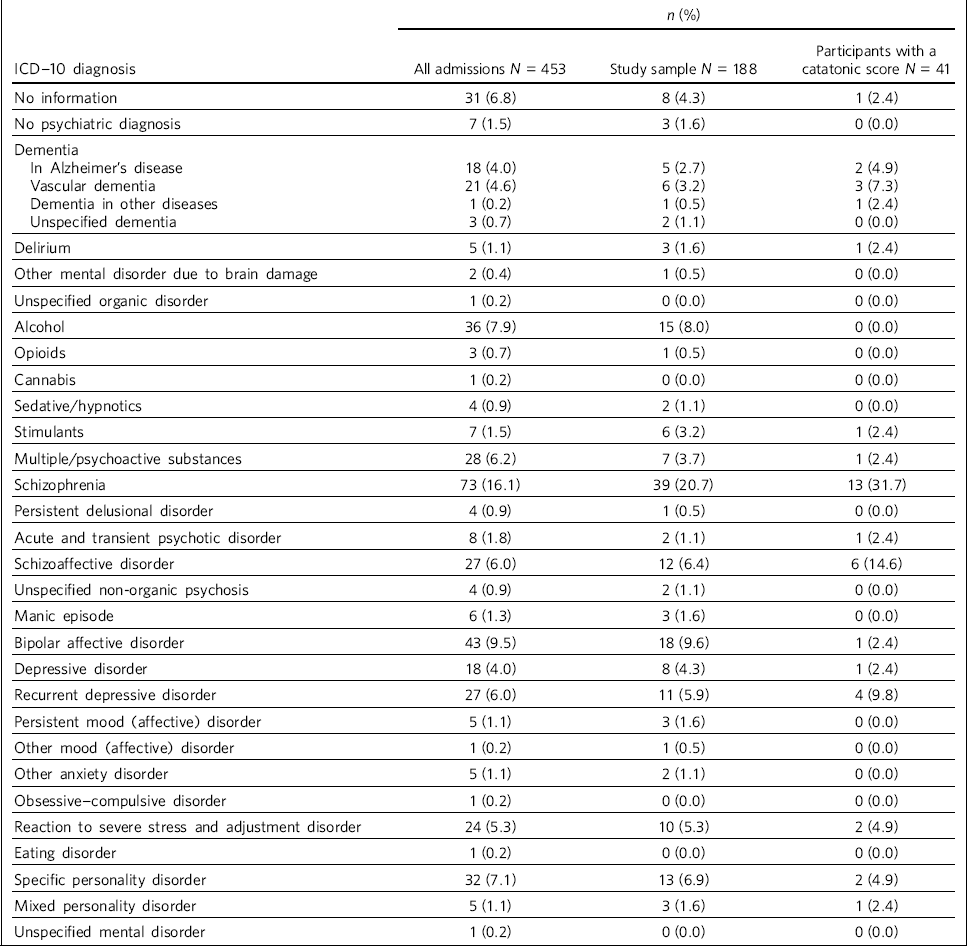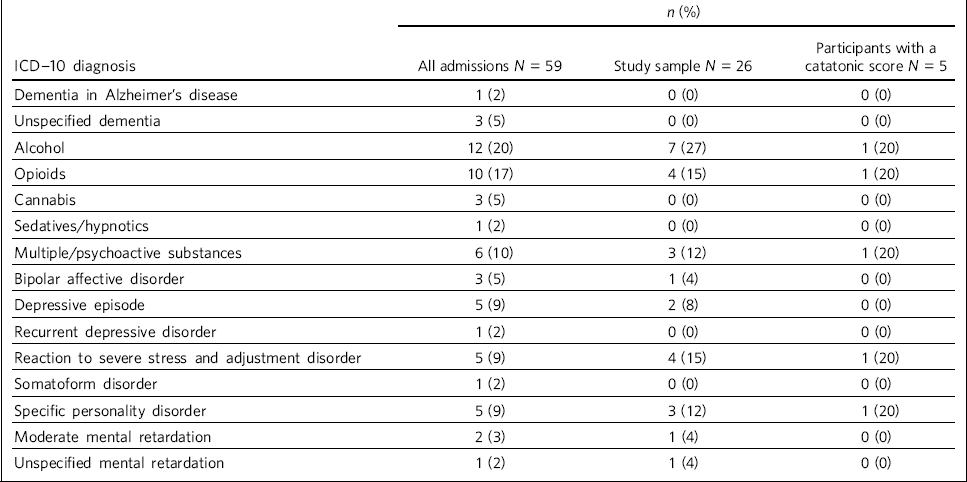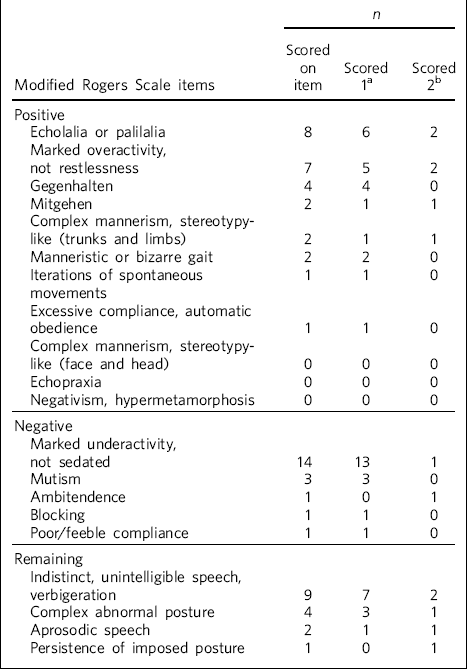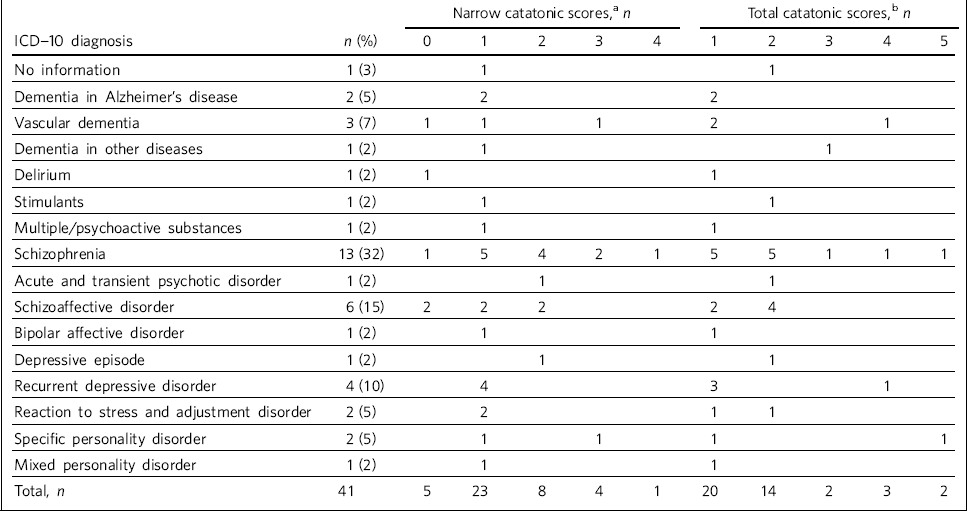Kahlbaum characterised catatonia as a specific disturbance in motor functioning which represents a phase in a progressive illness that includes stages of mania, depression and psychosis that typically ends in dementia. Reference Taylor and Fink1 Kraepelin incorporated features of catatonia into his concept of dementia praecox and Bleuler, under the heading of catatonic symptoms, gave the fullest account of schizophrenic abnormalities in movement, volition, overall behaviour and speech. Reference Lund, Mortimer, Rogers and McKenna2 Throughout most of the 20th century, clinicians considered catatonia as an exclusive subtype of schizophrenia. Reference Taylor and Fink1 Numerous authors argued against this view as catatonic features amid affective symptomatology were not uncommon. Reference Mahendra3 Whereas until 1960 the catatonic subtype made up a third of the total number of cases of schizophrenia, the prevalence shrank to 2–10% during the following decades. Reference Stompe, Ortwein-Swoboda, Ritter, Schanda and Friedmann4 The decline has been attributed to various causes, and includes early detection and management and a liberal and humane hospital atmosphere. Reference Mahendra3 Other reasons include a more restrictive definition of schizophrenia; more reliable exclusion of other cerebral diseases by improved neurological diagnosis; improved capabilities of psychopharmacological treatment; and the development of antipsychotic-induced motor abnormalities which favoured an unquestioning attribution of these signs to antipsychotic side-effects. Reference Stompe, Ortwein-Swoboda, Ritter, Schanda and Friedmann4
Most would now agree that catatonia is a non-specific but strongly differentiated syndrome which may appear in different psychiatric or medical conditions. Reference Peralta and Cuesta5 Mann et al Reference Mann, Caroff, Bleier, Welz, Kling and Hayashida6 view catatonia as a non-specific response of the central nervous system associated with various neurological, medical and psychiatric disorders. They consider neuroleptic malignant syndrome (a drug-related, febrile catatonic state with stuporous rigidity) to represent an antipsychotic-induced toxic or iatrogenic, organic form of lethal catatonia. Likewise, serotonin syndrome is considered to be a severe form of catatonia induced by an agent with different chemical characteristics. Reference Taylor and Fink1 There are views that catatonia is sufficiently common to warrant classification as an independent syndrome, Reference Taylor and Fink1 similar to delirium, since the latter cuts across specific illnesses and is not anchored in any one diagnosis. In ICD-10, catatonia is recognised only as a subtype of schizophrenia, 7,Reference Bush, Fink, Petrides, Dowling and Francis8 whereas the DSM-IV includes catatonia as a subtype of schizophrenia but also as a disorder caused by a medical condition and as a specifier of affective disorders. 9,Reference van der Heijden, Tuinier, Arts, Hoogendoorn, Kahn and Verhoeven10
Moskowitz Reference Moskowitz11 suggests catatonia may primarily be a fear reaction as the subjective state of many persons undergoing catatonic experiences is reported to be one of intense anxiety. Catatonia is considered a relic of ancient defensive strategies designed to maximise surviving a potentially lethal attack. Reference Moskowitz11 Moskowitz proposes that catatonic stupor (including mutism and immobility) is directly linked to tonic immobility (animals freezing in response to danger), whereas catatonic excitement is related to sympathetically mediated fight-flight responses. He suggests this thesis may help explain why benzodiazepines have been found to be extremely effective in treating catatonia, in some cases relieving symptoms within a few minutes. However, the evidence of their effectiveness in catatonia is mostly anecdotal and based on expert opinion - a Cochrane review Reference Gibson and Walcott12 could identify no randomised controlled trials to judge its effectiveness.
We aimed to measure the prevalence of catatonic signs in patients consecutively admitted to acute psychiatric wards in a district general hospital. We were not only looking for those who would receive a diagnosis of the syndrome but an inventory of catatonic features in this group of patients. We selected the Modified Rogers Scale Reference Lund, Mortimer, Rogers and McKenna2 to rate catatonic signs. This scale was originally assessed and validated in patients with schizophrenia. It was designed to rate both extrapyramidal and catatonic abnormalities as well as those classifiable as either so there was no need to decide the cause at the time of rating. This ‘non-prejudicial approach’ was considered to permit a score to be derived for catatonic symptoms uncontaminated by extrapyramidal phenomena. The use of this scale has subsequently been validated in patients with depression. Reference Starkstein, Petracca, Teson, Chemerinski, Merello and Migliorelli13
Method
Participants were those who were consecutively admitted to two adult and one old age psychiatric wards over a 10-month period (October 2007-July 2008). We delivered an educational and training session about catatonia to junior doctors and explained the use of the Modified Rogers Scale. Doctors completed the scale for patients during the initial clerk-in. Diagnosis on discharge was collected from the electronic patient information system.
Box 1 Items in Modified Rogers Scale
Catatonic items
A. Positive
-
• Gegenhalten
-
• Mitgehen
-
• Complex mannerism, stereotypy-like (face, head, trunk, limbs)
-
• Iterations of spontaneous movements
-
• Echopraxia
-
• Manneristic/bizarre gait
-
• Echolalia, palilalia, speech mannerism
-
• Marked overactivity, not restlessness
-
• Excessive compliance/automatic obedience
-
• Negativism, hypermetamorphosis
B. Negative
-
• Blocking
-
• Ambitendency
-
• Mutism
-
• Marked underactivity, not sedated
-
• Poor/feeble compliance
C. Remaining
-
• Complex abnormal posture
-
• Persistence of imposed posture
-
• Aprosodic speech
-
• Indistinct, unintelligible speech, verbigeration
Extrapyramidal items
-
• Simple abnormal posture
-
• Abnormal tone
-
• Simple brief, dyskinesia-like (face, head, trunk, limbs)
-
• Simple sustained, grimace-like (face, head, trunk, limbs)
-
• Increased blinking
-
• Decreased blinking
-
• Eye movements: to-and-fro/roving/conjugate deviation
-
• Abruptness/rapidity of spontaneous movements
-
• Slowness/feebleness of spontaneous movements
-
• Exaggerated quality to movements
-
• Gait: exaggerated associated movement
-
• Gait: reduced associated movement
-
• Gait: slow/shuffling
-
• Reported behaviour: underactive, overactive, postures, rituals, etc
Adapted from Lund et al. Reference Lund, Mortimer, Rogers and McKenna2
Scoring
Scores of items (Box 1) rating abnormalities that could represent, were affiliated with, or might be confused with tardive dyskinesia and Parkinsonism were disregarded. Scores on remaining items were considered to be phenomenologically non-extrapyramidal and therefore, by default, representative of catatonic disorder. In order to achieve this, the scale separates ‘positive’ and ‘negative’ catatonic phenomena. Positive phenomena represent the presence of an abnormality, whereas negative phenomena represent absence or diminution of normal function. The remaining catatonic items were felt not to be adequately classifiable as positive or negative and were included only in total catatonic scores. With these remaining catatonic items there was a degree of uncertainty about whether they might rate extrapyramidal symptoms in some cases. They were excluded when calculating narrow catatonic scores (positive score + negative score). Box 1 shows all the items on the scale. For each item a score was assigned: 0 abnormality absent, 1 abnormality definitely present and 2 abnormality marked or pervasive.
Results
The total number of admissions to all three wards over the study period was 453. There were 274 individuals admitted to adult ward 1 (60.5%), 120 to adult ward 2 (26.5%) and 59 to the old age ward (13.0%). The total number of forms completed was 188 (the study sample). We collected 111 forms from adult ward 1 (59.0%), 59 forms from adult ward 2 (31.4%) and 18 forms from the old age ward (9.6%). The overall return rate was 41.5%.
Considering all admissions, there were 245 males (54.1%) and 208 females (45.9%); the average age was 44.5 years. The average age of the study sample was 44.3 years. The sample comprised 111 males (59%) and 77 females (41%). Of the 188 in the study sample, 147 scored 0 on the Modified Rogers Scale (78.2%). This left 41 participants (21.8%) who had a total catatonic score. The average age in this group was 46.4 years; the group comprised 21 males (51.2%) and 20 females (48.8%). Table 1 shows the primary diagnoses in all admissions, in the study sample and in those with a catatonic score. From all admissions there were 59 participants with a secondary diagnosis (13.0%). In the study sample, 26 had a secondary diagnosis (13.8%), and of the 41 with a catatonic score, 5 had a secondary diagnosis (12.2%). Table 2 shows the spread of secondary diagnoses in the three groups.
Table 1 Primary diagnoses

| n (%) | |||
|---|---|---|---|
| ICD–10 diagnosis | All admissions N = 453 | Study sample N = 188 | Participants with a catatonic score N = 41 |
| No information | 31 (6.8) | 8 (4.3) | 1 (2.4) |
| No psychiatric diagnosis | 7 (1.5) | 3 (1.6) | 0 (0.0) |
| Dementia | |||
| In Alzheimer's disease | 18 (4.0) | 5 (2.7) | 2 (4.9) |
| Vascular dementia | 21 (4.6) | 6 (3.2) | 3 (7.3) |
| Dementia in other diseases | 1 (0.2) | 1 (0.5) | 1 (2.4) |
| Unspecified dementia | 3 (0.7) | 2 (1.1) | 0 (0.0) |
| Delirium | 5 (1.1) | 3 (1.6) | 1 (2.4) |
| Other mental disorder due to brain damage | 2 (0.4) | 1 (0.5) | 0 (0.0) |
| Unspecified organic disorder | 1 (0.2) | 0 (0.0) | 0 (0.0) |
| Alcohol | 36 (7.9) | 15 (8.0) | 0 (0.0) |
| Opioids | 3 (0.7) | 1 (0.5) | 0 (0.0) |
| Cannabis | 1 (0.2) | 0 (0.0) | 0 (0.0) |
| Sedative/hypnotics | 4 (0.9) | 2 (1.1) | 0 (0.0) |
| Stimulants | 7 (1.5) | 6 (3.2) | 1 (2.4) |
| Multiple/psychoactive substances | 28 (6.2) | 7 (3.7) | 1 (2.4) |
| Schizophrenia | 73 (16.1) | 39 (20.7) | 13 (31.7) |
| Persistent delusional disorder | 4 (0.9) | 1 (0.5) | 0 (0.0) |
| Acute and transient psychotic disorder | 8 (1.8) | 2 (1.1) | 1 (2.4) |
| Schizoaffective disorder | 27 (6.0) | 12 (6.4) | 6 (14.6) |
| Unspecified non-organic psychosis | 4 (0.9) | 2 (1.1) | 0 (0.0) |
| Manic episode | 6 (1.3) | 3 (1.6) | 0 (0.0) |
| Bipolar affective disorder | 43 (9.5) | 18 (9.6) | 1 (2.4) |
| Depressive disorder | 18 (4.0) | 8 (4.3) | 1 (2.4) |
| Recurrent depressive disorder | 27 (6.0) | 11 (5.9) | 4 (9.8) |
| Persistent mood (affective) disorder | 5 (1.1) | 3 (1.6) | 0 (0.0) |
| Other mood (affective) disorder | 1 (0.2) | 1 (0.5) | 0 (0.0) |
| Other anxiety disorder | 5 (1.1) | 2 (1.1) | 0 (0.0) |
| Obsessive–compulsive disorder | 1 (0.2) | 0 (0.0) | 0 (0.0) |
| Reaction to severe stress and adjustment disorder | 24 (5.3) | 10 (5.3) | 2 (4.9) |
| Eating disorder | 1 (0.2) | 0 (0.0) | 0 (0.0) |
| Specific personality disorder | 32 (7.1) | 13 (6.9) | 2 (4.9) |
| Mixed personality disorder | 5 (1.1) | 3 (1.6) | 1 (2.4) |
| Unspecified mental disorder | 1 (0.2) | 0 (0.0) | 0 (0.0) |
Table 2 Secondary diagnoses

| n (%) | |||
|---|---|---|---|
| ICD–10 diagnosis | All admissions N = 59 | Study sample N = 26 | Participants with a catatonic score N = 5 |
| Dementia in Alzheimer's disease | 1 (2) | 0 (0) | 0 (0) |
| Unspecified dementia | 3 (5) | 0 (0) | 0 (0) |
| Alcohol | 12 (20) | 7 (27) | 1 (20) |
| Opioids | 10 (17) | 4 (15) | 1 (20) |
| Cannabis | 3 (5) | 0 (0) | 0 (0) |
| Sedatives/hypnotics | 1 (2) | 0 (0) | 0 (0) |
| Multiple/psychoactive substances | 6 (10) | 3 (12) | 1 (20) |
| Bipolar affective disorder | 3 (5) | 1 (4) | 0 (0) |
| Depressive episode | 5 (9) | 2 (8) | 0 (0) |
| Recurrent depressive disorder | 1 (2) | 0 (0) | 0 (0) |
| Reaction to severe stress and adjustment disorder | 5 (9) | 4 (15) | 1 (20) |
| Somatoform disorder | 1 (2) | 0 (0) | 0 (0) |
| Specific personality disorder | 5 (9) | 3 (12) | 1 (20) |
| Moderate mental retardation | 2 (3) | 1 (4) | 0 (0) |
| Unspecified mental retardation | 1 (2) | 1 (4) | 0 (0) |
Table 3 shows the catatonic signs seen in order of frequency and the number of patients in the study scoring 1 (abnormality definitely present) and 2 (abnormality marked or pervasive). The highest narrow catatonic score was 4; the highest total catatonic score was 5. Table 4 shows the narrow and total catatonic scores by diagnosis. The most common diagnoses in the 41 participants with a total catatonic score were schizophrenia (all paranoid subtype; 10 males, 3 females), schizoaffective disorder (3 manic type, 2 unspecified type, 1 depressive type; 3 males, 3 females) and dementia (2 dementia in Alzheimer's disease (1 male, 1 female); 3 vascular dementia (2 males, 1 female); and 1 dementia in Parkinson's disease (male)). One of the four participants with recurrent depression (all female) experienced a mild episode, two had a severe episode with no psychotic symptoms and one had a severe episode with psychotic symptoms. The participant with a depressive episode (female) experienced an episode of moderate severity. The participant with bipolar affective disorder (female) had severe depression without psychotic symptoms. The two participants with a specific personality disorder (both female) had emotionally unstable personality disorder. The participant with a mixed personality disorder was female. In one of the two participants with drug-related diagnoses (both males), mental and behavioural disorders were caused by stimulants (psychotic disorder, predominantly manic symptoms) and in the other they were caused by multiple drug use and other psychoactive substances (harmful use). One of the participants with reaction to stress and adjustment disorder was female. When only narrow catatonic scores were considered, 5 of the 41 participants scored 0 (Table 4).
Table 3 Frequency of catatonic signs

| n | |||
|---|---|---|---|
| Modified Rogers Scale items | Scored on item | Scored 1a | Scored 2b |
| Positive | |||
| Echolalia or palilalia | 8 | 6 | 2 |
| Marked overactivity, not restlessness | 7 | 5 | 2 |
| Gegenhalten | 4 | 4 | 0 |
| Mitgehen | 2 | 1 | 1 |
| Complex mannerism, stereotypy-like (trunks and limbs) | 2 | 1 | 1 |
| Manneristic or bizarre gait | 2 | 2 | 0 |
| Iterations of spontaneous movements | 1 | 1 | 0 |
| Excessive compliance, automatic obedience | 1 | 1 | 0 |
| Complex mannerism, stereotypy-like (face and head) | 0 | 0 | 0 |
| Echopraxia | 0 | 0 | 0 |
| Negativism, hypermetamorphosis | 0 | 0 | 0 |
| Negative | |||
| Marked underactivity, not sedated | 14 | 13 | 1 |
| Mutism | 3 | 3 | 0 |
| Ambitendence | 1 | 0 | 1 |
| Blocking | 1 | 1 | 0 |
| Poor/feeble compliance | 1 | 1 | 0 |
| Remaining | |||
| Indistinct, unintelligible speech, verbigeration | 9 | 7 | 2 |
| Complex abnormal posture | 4 | 3 | 1 |
| Aprosodic speech | 2 | 1 | 1 |
| Persistence of imposed posture | 1 | 0 | 1 |
Table 4 Catatonic scores by diagnosis

| Narrow catatonic scores,a n | Total catatonic scores,b n | ||||||||||
|---|---|---|---|---|---|---|---|---|---|---|---|
| ICD–10 diagnosis | n (%) | 0 | 1 | 2 | 3 | 4 | 1 | 2 | 3 | 4 | 5 |
| No information | 1 (3) | 1 | 1 | ||||||||
| Dementia in Alzheimer's disease | 2 (5) | 2 | 2 | ||||||||
| Vascular dementia | 3 (7) | 1 | 1 | 1 | 2 | 1 | |||||
| Dementia in other diseases | 1 (2) | 1 | 1 | ||||||||
| Delirium | 1 (2) | 1 | 1 | ||||||||
| Stimulants | 1 (2) | 1 | 1 | ||||||||
| Multiple/psychoactive substances | 1 (2) | 1 | 1 | ||||||||
| Schizophrenia | 13 (32) | 1 | 5 | 4 | 2 | 1 | 5 | 5 | 1 | 1 | 1 |
| Acute and transient psychotic disorder | 1 (2) | 1 | 1 | ||||||||
| Schizoaffective disorder | 6 (15) | 2 | 2 | 2 | 2 | 4 | |||||
| Bipolar affective disorder | 1 (2) | 1 | 1 | ||||||||
| Depressive episode | 1 (2) | 1 | 1 | ||||||||
| Recurrent depressive disorder | 4 (10) | 4 | 3 | 1 | |||||||
| Reaction to stress and adjustment disorder | 2 (5) | 2 | 1 | 1 | |||||||
| Specific personality disorder | 2 (5) | 1 | 1 | 1 | 1 | ||||||
| Mixed personality disorder | 1 (2) | 1 | 1 | ||||||||
| Total, n | 41 | 5 | 23 | 8 | 4 | 1 | 20 | 14 | 2 | 3 | 2 |
Of the 41 participants with catatonic scores, 9 were in the old age ward (22.0%). Dementia was the most common diagnosis in six participants (4 males, 2 females). The other three had schizoaffective disorder (unspecified type, male) and recurrent depressive disorder, current episode severe without psychotic symptoms (both females).
Discussion
The overall return rate in our study was low (41.5%). Reasons for this include forgetting to fill in the form at the time of clerk-in and accessibility of the forms to prompt the doctors. The forms were not easily available in accident and emergency departments, where some patients were first examined. Despite this the study sample appears representative to all admissions from the point of view of primary diagnosis, secondary diagnosis and age. There were more males in the study sample. This may have led to bias if doctors were more likely to remember to fill in the form if the patient was more severely unwell and more likely to score on one of the items of the scale. If we generalise our findings to all admissions then the prevalence of any narrow catatonic score was 19.1% (36/188). If the threshold is raised and only a minimum score of 2 is taken to be significant, the prevalence drops to 6.9% (13/188). If we assume the ‘worst case’ (those for whom forms were not completed score 0), the prevalence of any narrow catatonic score is 7.9% (36/453) and the prevalence of those scoring 2 is 2.9% (13/453).
Most of the participants with catatonic scores with schizophrenia were male (10/13). When considering schizoaffective disorder the proportion of females increased. Those diagnosed with affective disorders and personality disorders were much more likely to be females. This may reflect clinicians' pattern of diagnosis and more severe psychosis in males in our sample. Those with the highest total catatonic scores were a male with schizophrenia and a female with emotionally unstable personality disorder (borderline type). When considering narrow catatonic scores, the highest scorer was a male with schizophrenia.
The predominant diagnosis type in our study sample was a psychotic disorder (paranoid schizophrenia, schizoaffective, acute and transient psychotic disorder, stimulant-induced psychosis in 21 participants). Although this is contrary to other studies suggesting catatonia is more commonly associated with mood disorders, Reference Rajagopal14 our study was investigating those with catatonic signs rather than a diagnosis of catatonia. When the reliability and validity of the scale was investigated, no breakdown of scores was given to compare the severity of catatonic signs in our sample and Lund et al's Reference Lund, Mortimer, Rogers and McKenna2 samples. We found catatonic signs across functional and organic diagnoses as predicted by Taylor & Fink. Reference Taylor and Fink1
It can be argued that some of the catatonic items in the scale are non-specific (e.g. overactivity, underactivity, mannerisms) and so there is the possibility of false positives, especially as even a score of 1 was considered to be significant. However, the scale does not give a positive or negative result or purport to identify those with catatonia and those without. It attempts to identify signs uncontaminated by extrapyramidal features and therefore phenomenologically catatonic. No item is pathognomonic of catatonia. There is no cut-off above which catatonia can be diagnosed. No one in our sample had a diagnosis of catatonic schizophrenia. Our study suggests that catatonic signs are seen in psychotic, affective, neurotic and stress-related disorders as well as dementia, personality disorder and drug-related mental disorder but they were most likely seen in psychotic illnesses. In addition, higher scores were more likely in participants with psychotic illness.
The most common catatonic signs in our sample were motor signs (underactivity, overactivity, gegenhalten). Motor signs may reflect severity of psychiatric illness. Rogers Reference Rogers15 described a ‘conflict of paradigms’ hypothesis, which implied that emphasis on the distinction between intrinsic and drug-induced movement disorders might be misplaced because of overlap in observable characteristics of these disorders and in underlying neuropathology. He also suggests that trying to separate absolutely motor disorder caused by disease from that caused by medication is an artificial exercise and that time limits for residual action of discontinued medication are arbitrary. He further argues that as soon as motor disorder of psychiatric illness is regarded as representing cerebral dysfunction, the most ‘parsimonious hypothesis’ for antipsychotic-induced motor disorder is interaction between drug and disease. This explains the similarity of motor abnormalities in those treated, and those apparently never treated, with antipsychotic medication Reference Owens, Johnstone and Frith16 and justifies the ‘non-prejudicial’ approach to the assessment of these disorders. Reference Liddle17 Rogers concludes that attributing motor disorder to undiagnosed neurological disease becomes superfluous if severe psychiatric illness is regarded as neurological disease. Reference Rogers15 These conclusions do not help us understand why we found catatonic signs in those with neurotic and stress-related diagnoses and personality disorder.
Our study supports the hypothesis that catatonic signs are not anchored in any one diagnosis or diagnosis type and are on a spectrum of severity and quantity. Prevalence of these signs is higher than often presumed. A diagnosis of ‘catatonia’ may be as nondescript as that of ‘delirium’, but similarly to delirium, the cause must be found to understand the context of the signs and monitor the success of treatment.
Acknowledgements
Thanks to all the junior doctors who collected data, Mrs Wendy Sime for retrieving admission and discharge details and Dr Michelle George for retrieving diagnoses.







eLetters
No eLetters have been published for this article.